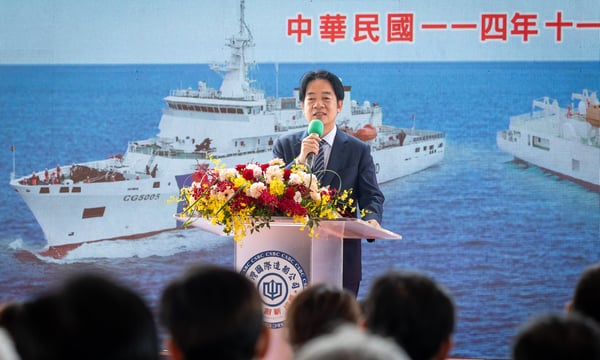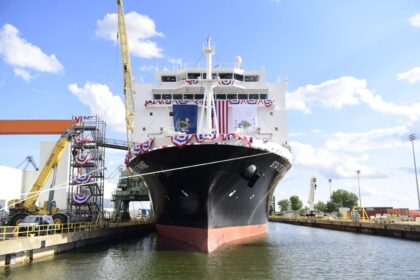A meeting between U.S. President Donald Trump and Chinese President Xi Jinping on the sidelines of APEC in late October concluded, unusually enough, without any mention of Taiwan. That contradicted what Trump had stated ahead of the meeting.
Experts have been divided on the meaning of Taiwan’s omission from the Trump-Xi meeting, which ended with reductions in tariffs imposed on China by the United States, and Beijing agreeing to pause some of its restrictions on rare earth exports. It may have been that Trump and Xi did not have time to discuss Taiwan during their brief, 100-minute meeting, which apparently focused exclusively on trade issues. Others have suggested that Xi might have been reluctant to bring up Taiwan and risk a slap in the face from the mercurial Trump on the issue. Or perhaps China’s strategic priorities are elsewhere and Xi has more pressing matters than Taiwan on his plate at present.
Either way, both international discourse around Taiwan, as well as the actions of the Lai administration domestically in Taiwan ahead of the Trump-Xi meeting, are worth examining.
While the Taiwan issue didn’t feature at the Trump-Xi summit, at around the same time the Taiwan Affairs Office was busily engaging in messaging alongside the 80th anniversary of Japan’s surrender of Taiwan to the Republic of China. Officials in Beijing were emphatic on reinforcing the message that Taiwan could maintain the same level of autonomy reserved for Macau and Hong Kong if it accepted Chinese rule.
It is surprising that China is still intent on “One Country, Two Systems” being the blueprint for unification between Taiwan and China, when the erosion of freedoms and rights in Hong Kong has made that model a non-starter for Taiwanese. The term “One Country, Two Systems” has become so toxic in Taiwan that the Kuomintang (KMT), which is on friendlier terms of Beijing, refuses to embrace the idea. The KMT’s 2020 presidential candidate Han Kuo-yu repeatedly lashed out at the idea in that year’s campaign season, as did 2024 KMT presidential candidate Hou Yu-ih. In recent days President Lai Ching-te has sought to reinforce the message that Taiwan would not accept some version of One Country, Two Systems.
The Lai administration sought to shore up faith in the United States ahead of the Trump-Xi talks, reassuring the public that bilateral ties with the U.S. were steady, and that there was continued progress on trade talks. After Taiwan was not mentioned during the talks, this, too, was framed as a sign of the strength of Taiwan-U.S. ties – even if in other circumstances, Taiwan would welcome public acknowledgment from a U.S. head of state.
Democratic Progressive Party (DPP) presidential administrations, including the Lai administration as well as the preceding Tsai administration, have sought to reassure the Taiwanese public of the reliability of the U.S. as an ally against China. In turn, the opposition KMT has been criticized by the DPP and its allies as having embraced “U.S.-skeptic discourse” – rhetoric designed to dissuade the public that the United States would support Taiwan in wartime. It is thought that the Taiwanese public will be less willing to resist a hypothetical military action by China if the Taiwanese public did not have faith that the U.S. would eventually intercede on its behalf.
Even so, a series of editorials published in Time Magazine released shortly ahead of the Trump-Xi meeting cast doubt on the advisability of continued U.S. support for Taiwan. The three editorials were penned respectively by American defense expert Lyle Goldstein, Time editor Charlie Campbell, and retired People’s Liberation Army senior colonel Zhou Bo. The op-eds broadly took the stance that the Trump administration should dial back support for Taiwan, while terming Lai an aggressor who has sought to disrupt cross-strait relations.
The op-eds were regarded in Taiwan’s policy circles as an attempt to influence American public opinion shortly before Trump and Xi’s meeting. Several weeks prior, a New York Times op-ed by Jennifer Kavanaugh led to a similar reaction in Taiwan. Both the New York Times op-ed and Time Magazine series of op-eds were criticized for “victim-blaming” in casting Lai as the aggressor against China, rather than the other way around. Critics in Taiwan also complained that these publications failed to consider the viewpoints of any Taiwanese in the future of Taiwan, by how Trump could “prevent a war over Taiwan,” but never what Taiwanese themselves would do if invaded.
Given this set of circumstances, the Lai administration seems increasingly conscious of the possibility that it has lost American public opinion. In particular, a large uproar ensued in Taiwan after the publication of an article on Substack in August by former Trump administration official Christian Whiton, entitled “How Taiwan Lost Trump.” Whiton, a former special adviser to the State Department, was read as a Washington insider, and his views were taken as reflective of the opinions of the Trump administration. As Whiton framed it, Taiwan had lost the support of Trump through its refusal to increase defense spending and the military instead being preoccupied with “woke” social issues such as fighting climate change.
It’s an odd claim, as there has been little if any discussion of environmentalism from the Taiwanese military in past years. The Taiwanese military has played absolutely no role in the increasingly contentious debate between the DPP and KMT on renewable energy.
But in the months since Whiton’s article, the Lai administration has reportedly been deliberately seeking to cultivate ties with social media influencers popular in MAGA Republican circles. And after Whiton lashed out at Taiwanese officials for publishing in the Washington Post – considered by Whiton to be a publication that stands opposed to the Trump administration – one notes a new emphasis placed by Taiwanese government officials or DPP politicians on publishing in the Washington Times and other conservative outlets.
Moreover, since Whiton’s article, Taiwanese conservatives have increasingly sought to make public displays of how their political stances are in line with MAGA Republicans. In past weeks, socially conservative pro-independence groups such as the Formosa Republican Association and Taiwan Solidarity Union have held several memorial ceremonies for assassinated influencer Charlie Kirk, a little-known figure in Taiwan before his death.
In a similar vein, the Lai administration has sought to use public shows of support for Israel to appeal to Republicans aligned with the Trump administration. During Lai’s National Day address on October 10, Lai declared plans to construct a “T-Dome” reminiscent of Israel’s “Iron Dome” air defense system. Later in the month, Lai hosted a visit from the prominent pro-Israel lobbying organization AIPAC, where he drew comparison between Taiwan and Israel in public comments that referenced the Biblical story of David and Goliath.
It is to be seen if the Lai administration’s charm offensive makes any headway among Trump-aligned Republicans. Lai’s public image is sharply different than his progressive predecessor, Tsai Ing-wen. Ironically, if this has been detrimental to his standing in Taiwanese domestic politics, the difference in their public images may be an asset to him in appealing to American Republicans.
Yet Lai’s efforts in appealing to Americans may be made easier if the alternative of the KMT is viewed with more suspicions in the United States. Newly elected KMT party chair Cheng Li-wun has already drawn controversy in the weeks after her election victory. Cheng evidenced a strong pro-China streak, with comments stating that she hoped to see Taiwanese “proud to be Chinese” and that “Taiwan and the mainland should join forces to reach new heights in human civilization.”
Cheng has taken a stance against increasing Taiwan’s defense budget to 5 percent of the GDP, as called for by the Trump administration. She suggested that the Trump administration was treating Taiwan like an “ATM” and seeking to extort it for money – a common rhetorical point that the KMT has embraced about U.S. arms sales to Taiwan. By contrast, Cheng suggested that increasing defense spending would embroil Taiwan in “an endlessly escalating arms race.”
Cheng also drew criticism for her comments on Ukraine and Russia. Even as MAGA Republicans have sought to dial back support for Ukraine, the DPP has been emphatic that the United States should continue supporting Ukraine because this will shore up public confidence in U.S. commitment. Taking the opposite stand, however, Cheng referred to Russian President Vladimir Putin as a “democratically elected” leader in an interview with German public broadcaster Deutsche Welle, and suggested that the war in Ukraine only broke out because of NATO’s aggressive eastward expansion. Cheng continued to double down on such comments, affirming Putin as a democratically elected leader, when questioned after the interview.
Taichung mayor Lu Shiow-yen – generally seen as a moderate on cross-strait relations – is seen as the KMT’s frontrunner for the 2028 presidential nomination. But Cheng’s chairship of the party potentially threatens to undermine Lu’s messaging on cross-strait relations, a major source of her appeal to the general public. Cheng’s victory occurred despite allegations from KMT figures traditionally thought of as hardline on the issue of unification, such as media commentator Jaw Shaw-kong, that her campaign was being backed by China.
Indeed, Cheng has stated that she is willing to meet with Chinese President Xi Jinping to broker peace. On the heels of the meeting between Trump and Xi, in which Taiwan did not come up, will Cheng be next in line to meet with the Chinese leader?






